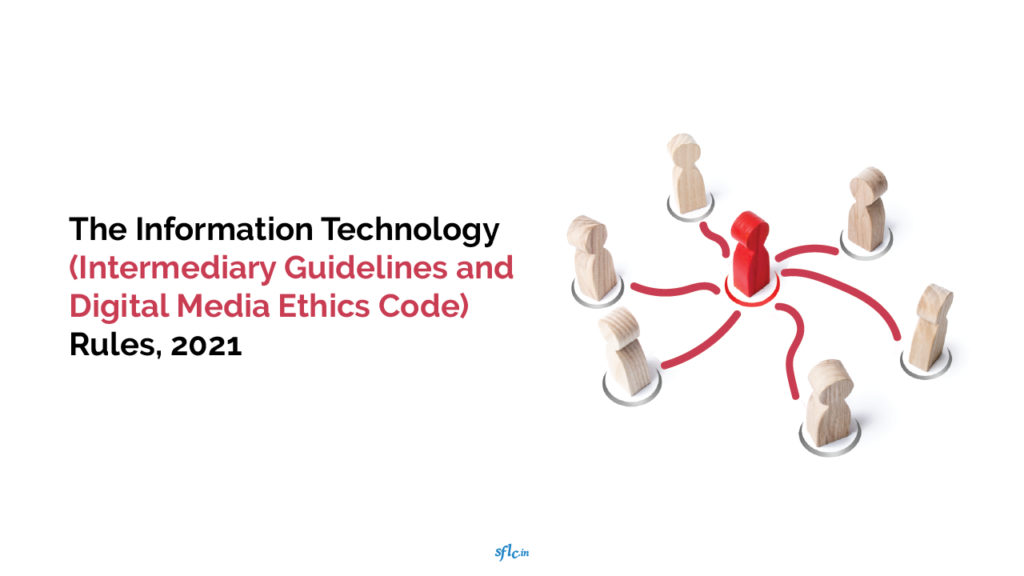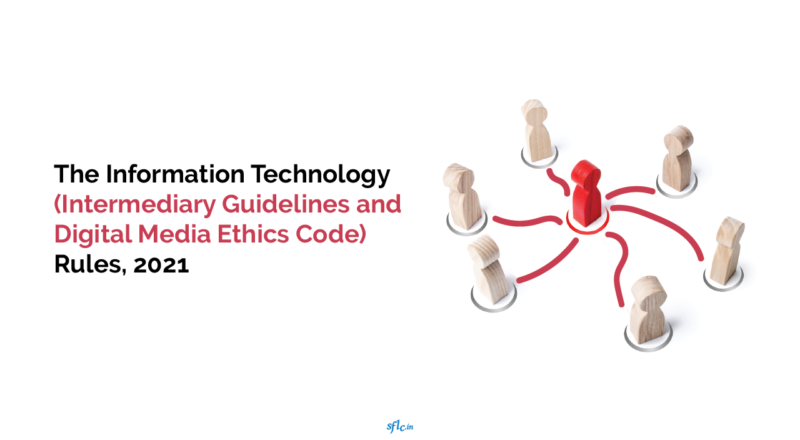As we all are aware that India has no codified privacy laws in place but this area of law is governed by the Constitution, Precedents, Contract Act, 1872 and Information Technology Act, 2000 (hereinafter referred to as IT Act). With time and as per the need of the society, the Government of India has notified the regulations to regulate the areas on which no laws are in place. Section 87 of the IT Act, 2000 is enabling provision and confers a wide range of powers on Central Government to notify rules by official/Electronic gazette in order to carry out the provisions of IT Act. Therefore, by virtue of the said section & Information Technology (Intermediaries Guidelines) Rules, 2011 (link of the Regulation- https://www.meity.gov.in/writereaddata/files/GSR314E_10511%281%29_0.pdf) the Government notified recent Rules dated 25th February 2021.

In the past also several such regulations were notified by the Government of India (GOI) and recently on 25th February, 2021 the GOI notified the Information Technology (Intermediaries and Guidelines & Digital Media Ethics Code) Rules, 2021 (link of the Regulation – https://mib.gov.in/sites/default/files/IT%28Intermediary%20Guidelines%20and%20Digital%20Media%20Ethics%20Code%29%20Rules%2C%202021%20English.pdf).
The 16 pages document in my opinion is probably a noose for Social Media Platforms like Instagram, Twitter, Facebook, WhatsApp etc. Surprisingly, except twitter all of them are owned by the Social Media Giant Mr. Mark Zuckerberg who is often made guilty for Antitrust Violation & illegal Monopolization. Well, this is a separate topic which we will not discuss here in this article.
The rule has the definition of Digital Media – “which means digitized content transmitted over the Computer network or Internet and includes content received, stored, transmitted, edited or processed by an intermediary or publisher of news & current affairs or publisher of online curated content”. The definition is wider and covers almost all kinds of content in digital form.
The Regulation mentions Intermediary quite often the term intermediary which simply means ‘a person who acts as a link’.
The Code enables any person who has grievance with respect to the content he/she can furnish his grievance under Rule 11 (Chapter II) of the said Regulation, the Publisher himself/herself has to form its internal officer to resolve the issue, which is also a Self-Regulating Mechanism at Level-1. This provision indicates a grievance redressal mechanism (a compliance officer) of its own. The decision of the Grievance officer shall be made within 15 days.
Rule 12 (chapter III) of the Regulations again speaks of Self Regulating-Body, “Self-Regulating Mechanism At Level–2” which is one or more self-regulating bodies of publishers (Independent bodies of Publisher or Association) which has to be headed by the retired Supreme Court/High Court judges or eminent person from the field of Media, Broadcasting etc. the body after its constitution to be registered within 30 days with Ministry of Electronics and Information Technology.
Rule 13 (Chapter IV) provides for Oversight Mechanism – Level 3, this provision promotes ministry to co-ordinate and facilitate the adherence to this code and develop oversight mechanism and Publish a charter, establish an inter-departmental committee for Grievance hearing, refer the grievance to Inter-departmental Committee under rule 12.
Furnishing of Information (Chapter V)
The publishers operating in the territory of India are mandated to furnish the details of its entity along with such documents for the purpose of enabling communication and coordination within 30 days of the publication of these rules. They are also required to publish periodic compliance reports every month (grievance received and action taken thereon).
Rule 4 of the Regulation puts an additional due diligence to be undertaken/observed by the social media intermediary and they are-
- Appointment of Chief Compliance Officer
- Appointment of Nodal Contact Person for 24*7 who has to coordinate with the law enforcement agencies.
- Appointment of Residence Grievance Officer.
- Publication of periodic compliance reports every Month.
- Significant social media entities who primarily provide messaging services are mandated to enable the identification of the first originator of the information on its computer resource as may be required by judicial order passed by court of Competent Jurisdiction or an order passed u/s 69 of the IT Act, 2000 by the competent authority along with a copy of such information in electronic form (Rule 4(2)).
Please note upon the breach of section 69 of the IT Act, 2000 provides for penal provisions which may extend to 7 years and fine upon its breach to assist the agency
After this notification the Central Government provided a three months window to Social Media Platforms in order to comply with the rules which ended on 25th May 2021.

Thereafter, WhatsApp approached Delhi High Court and challenged the rule 4(2) of the regulation- the traceability clause (refer point no.5 above), traceability means to trace the person who sent the message. WhatsApp’s contentions are following-
- The said traceability clause is mandatory in nature and hence forces the private companies to collect and store who-said-what and who-share-what and on daily basis billions of messages are transmitted on cyberspace and this will require the storage of more data than its need which has no purpose other than the compliance of law enforcement agencies when asked.
- The regulations will force them to break the end-to-end encryption which is antithetical to end to end encryption and core privacy principles.
- The clause is unconstitutional and violative of people’s right to privacy guaranteed under the Judgement of Justice K.S. Puttaswamy (Retd.) VS. Union of India (SC 2017). Right to Privacy includes the right to anonymity.
- The regulations are violative to fundamental rights to freedom of speech and expression, with encryption users feel safe to communicate freely.
On 26th May 2021 Ministry of Electronic and IT published its clarificatory (read here- https://pib.gov.in/PressReleseDetailm.aspx?PRID=1721915) and pointed out the following-
- The GOI recognizes the Right to Privacy, the norms are the proposed measures which will not impact the functioning of WhatsApp.
- It is in the public interest to detect the offender who initiated the mischief which led the crime to happen.
- The challenge by WhatsApp is at the very last moment, an unfortunate attempt to prevent the enforcement,
- All operations running in India are subject to the Lex Loci (laws of the land).
- The established judicial dictum is that “No fundamental right is absolute”.
Conclusion:
The intention of the MaitY seems clear that it wants to know the source of the mischief creator in order to curb the instances of crime which does seem in the public interest. However, the execution of the regulations seems a challenge from the point of view of social media platforms as the Regulations seek to build three tier redressal forums and time bound compliance will be a tough task for the intermediaries.
In my personal opinion the regulation seems a violation of right to privacy but as correctly said no right is absolute, especially in a country like India where fake news and defamation trend is persisting on a daily basis and leads to create riots and disharmony in the society. Definitely India cannot forget the Delhi riots, West Bengal Post Poll violence, lynching etc. knowing the creator or originator of the nuisance/mischief will definitely help the justice system to serve better.
However, the biggest worry is the freedom of speech where one will always be afraid to open his/her mouth as the sword of “Traceability’ will always work as a hunter man. The unauthorized use of one’s computer system for the purpose of transferring the malice will also create several scapegoats hence, to curb this issue, strict law & rule of evidence should be made little loose so that one can prove his/her innocence.
References–
- The Hindu Newspaper
- Live Law
- Website of Ministry of Electronics and Information Technology.
- Indian Kanoon

